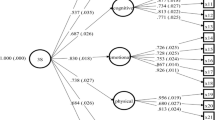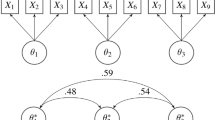Abstract
Multiple Discrepancies Theory – MDT – (Michalos, 1985)has been established as a leading theory of lifesatisfaction, on the basis of which numerous studieson satisfaction have been designed. Previous researchexamining overall and life facet satisfactionrelationships combined various approaches tounderstanding the interrelationships between thevariables by which individuals measure theirsatisfaction in life. Recently, Lance, Mallard andMichalos (1995) extended the scope of study byexamining the theoretical relationship between overalllife satisfaction (OLS) and satisfaction in variouslife facets (life facet satisfaction – LFS) among1,354 US college students. The present study extendsMDT one step further by applying a Facet Theory (FT)statistical approach to our understanding of the sameset of data. In this way a holistic model emerges,presenting not only the relationship between OLS andLFS, but also the interrelationships between and amongeach and every facet. Results of this analysis arepresented through the correlation matrix and SmallestSpace Analysis (SSA) diagrams. These results arecompared to Levy and Guttman’s (1975) figures in theirstudy on the structure of well-being; although the twostudies examined different populations and askeddifferent questions, the final structural organizationof the data is strikingly similar.
Similar content being viewed by others
References
Borg, I. and J. Lingoes: 1987, Multidimensional Similarity Structure Analysis (Springer Verlag, New York).
Canter, D. (ed.): 1985, Facet Theory: Approaches to Social Theory (Springer Verlag, New York).
Gratch, H. (ed.): 1973, Twenty-Five Years of Social Research in Israel (Jerusalem Academic Press, Jerusalem).
Guttman, L.: 1982, ‘Facet theory, smallest space analysis, and factor analysis’, Perceptual and Motor Skills 54, pp. 491–493.
Guttman, L.: 1968, ‘A general nonmetric technique for finding the smallest coordinate space for a configuration of points’, Psychometrika 33, pp. 469–506.
Guttman, L.: 1964, ‘The structure of interrelations among intelligence tests’, Invitational Conference on Testing Problems (ETS, Princeton).
Guttman, L.: 1954, ‘A new approach to factor analysis: the radex’, in P. F. Lazarsfeld (ed.), Mathematical Thinking in the Social Sciences (The Free Press, Illinois).
Headey, B., R. Veenhoven and A. Wearing: 1991, ‘Top-down versus bottom-up theories of subjective well-being’, Social Indicators Research 24, pp. 81–100.
James, L. R. and B. K. Singh: 1981, ‘An introduction to the logic, assumptions, and basic analytic procedures of two-stage least squares’, Psychological Bulletin 85, pp. 1104–1122.
Lance, C. E., G. J. Lautenschlager, C. E. Sloan and P. E. Varca: 1989, ‘A comparison between bottom-up, top-down, and bidirectional models of relationships between global and life facet satisfaction’, Journal of Personality 57, pp. 601–624.
Lance, C. E., A. G. Mallard and A. C. Michalos: 1995, ‘Tests of the causal directions of global-life facet satisfaction relationships’, Social Indicators Research 34, pp. 69–92.
Levy, S. (ed.): 1994, Louis Guttman on Theory and Methodology: Selected Writings (Dartmouth U., NH).
Levy, S. and L. Guttman: 1975, ‘On the multivariate structure of well-being’, Social Indicators Research 2, pp. 361–388.
Michalos, A. C.: 1991a, Global Report on Student Well-Being, Vol. 1 (Springer-Verlag, New York).
Michalos, A. C.: 1991b, Global Report on Student Well-Being, Vol. 2 (Springer-Verlag, New York).
Michalos, A. C.: 1985, ‘Multiple discrepancies theory (MDT)’, Social Indicators Research 16, pp. 347–413.
Rosenberg, M.: 1965, Society and the Adolescent Self Image (Princeton University Press, Princeton).
Young, F.: 1987, ‘Multidimensional scaling: History, theory and applications’, in R. M. Hamer (ed.) (L. Erlbaum Associates, NJ).
Author information
Authors and Affiliations
Rights and permissions
About this article
Cite this article
Cohen, E.H. A Facet Theory Approach to Examining Overall and Life Facet Satisfaction Relationships. Social Indicators Research 51, 223–237 (2000). https://doi.org/10.1023/A:1007019526236
Issue Date:
DOI: https://doi.org/10.1023/A:1007019526236




